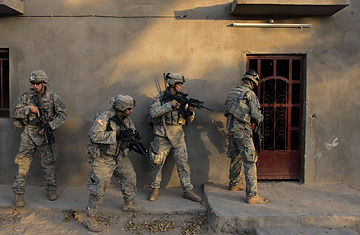
U.S. soldiers prepare to breach a door to an Iraqi home during a patrol in southern Baghdad.
The comments by Iraq's deputy foreign minister hardly caused a stir when they appeared Saturday in Asharq al Awsat, an Arabic newspaper published across the Middle East. But they are a strong indication of the depth of the Bush Administration's military commitment to the region. "Iraq needs a new resolution to determine the shape of the relationship between the two countries and how to cooperate with the U.S. forces," Labid Abawi was quoted as saying. "We will ask the Council to include an article that allows Iraq to enter into negotiations with the United States to reach long-term security agreements to meet Iraq's security needs bilaterally."
It all seemed to be standard diplo-speak, designed to set up a provision calling for lower numbers of U.S. forces. But a close parsing of the statement shows that Abawi and the government of Iraq are seeking to replace the existing United Nations–sponsored pact permitting U.S.-led forces in Iraq, establishing in its place a long-term, bilateral security agreement directly between Iraq and the United States. And while the proposed details have yet to emerge, similar U.S. agreements with other nations in the region — including Bahrain, Kuwait, Saudi Arabia, the United Arab Emirates and Qatar — have all involved a 10-year "protection" period, at minimum.
The exact parameters of the deals for each country are classified. But generally the agreements function like 10-year protection contracts saying that the United States will guarantee the security of a signatory country. In return, the United States is allowed to base troops, dock ships and store military hardware in those countries in furtherance of its efforts to project force in the Middle East.
For months in Washington, endless discussions about how and when U.S. troops should leave Iraq have failed to include any meaningful dialogue on the reality both the current Iraqi government and the Bush Administration seem to have accepted: U.S. troops are not leaving, at least not in any great number any time soon. If the agreement Abawi outlined comes to pass, U.S. forces would remain in Iraq in significant numbers for at least another decade if not longer.
Through its agreements with nations in the region, the U.S. military has steadily built up its presence in the Persian Gulf over the decades as it has faced foes such as Saddam Hussein's Iraq and, these days, Mahmoud Ahmadinejad's Iran. The United Arab Emirates, for example, signed a bilateral defense pact with the United States in 1994. The terms of that agreement remain classified, but the presence of U.S. forces in this corner of the Middle East is hardly a secret. About 1,800 U.S. military personnel, mostly with the Air Force, live on military bases here. And the U.A.E. Port of Jebel Ali, one of the few docks capable of handling a U.S. aircraft carrier, gets more visits from Navy ships than any other port outside the United States. Qatar signed a bilateral defense pact with the United States in 1992. Today, the sprawling al-Udeid airbase there is home to roughly 6,000 troops. Another 3,400 or so troops live at As-Sayliyah, a massive storage facility where the United States keeps things like tanks and Bradley fighting vehicles ready for use in the Middle East, ostensibly in case of conflict with the remaining U.S. rival in the region, Iran.
How long do such bilateral agreements last? In February of 1998, the United States marked the 50th anniversary of its naval command center in Bahrain. About 3,000 military personnel, mostly from the Navy, currently live there on yet another huge base. The complex covers roughly 100 acres, but there are plans to expand.
